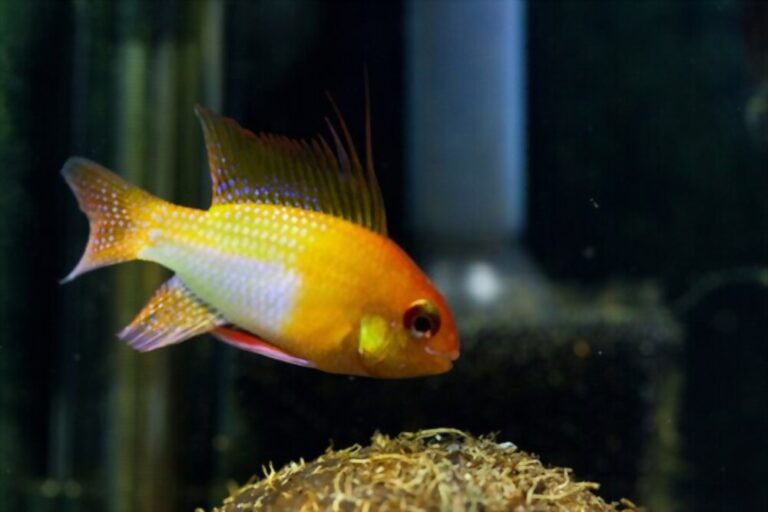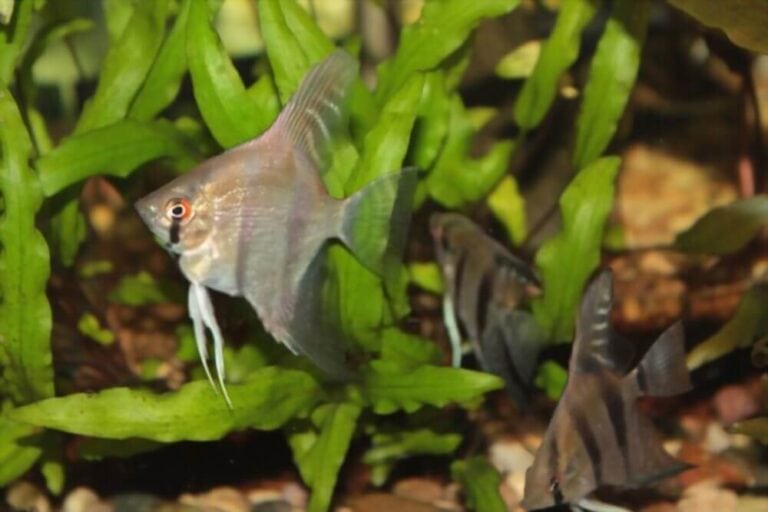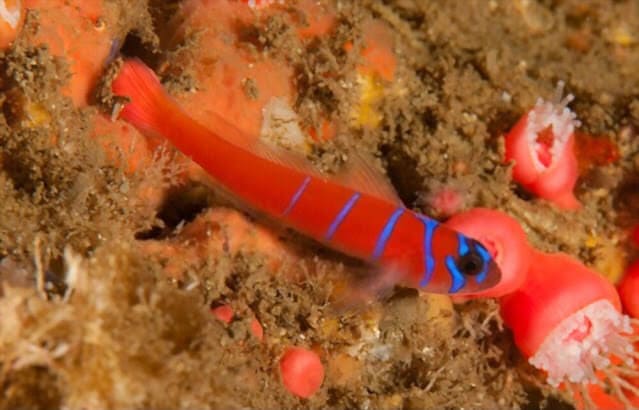Coral Beauty Angelfish Care: Size, Lifespan, Tank, & Mates
Coral beauty angelfish is one of the most pet fishes in the aquarium trade and is very popular among beginners and expert aquarists. We will discuss the Caring, Diet, Tank requirements, and essential things for Coral Beauty Angelfish briefly in this post.
It is a dwarf angelfish belonging to the genus ‘centropyge.’ Scientifically, it is known as Centropyge bispinosus. At the same time, commonly, people have given it different names such as Dusky Angelfish, Spine angelfish, and Coral beauty fish.
There are many reasons for keeping coral beauty angelfish if you are looking for some eye-catching fish for your saltwater aquarium.
Size of Coral Beauty Angelfish
The coral beauty is a small colorful version of angelfish reaching only up to a maximum of 4 inches. In comparison, the smaller members are just 1 inch or a little more below 2 inches long.
They have slender oval-shaped bodies with rounded fins. This dwarf angelfish is the adornment of saltwater aquariums because of its size and overall physical appearance.
Their size and diet have a crucial role in their habitat. They have made the small live rocks and the dense reefs home to live and hide from the predators because of this small size.
Their sizes determine their Sexes as well. All of the coral beauty angelfish are born as a female. As they grow up, the larger ones become male.
They live in breeding groups, which include one male and 2 to 5 females. If the male of the group dies, the next one of large size will take its position.
Lifespan of Coral Beauty Angelfish
The coral beauty angelfish can be your companion for a long time but not longer than in the wild. It can live up to 10 to 15 years in the wild.
But the data collected from different aquarists suggest that it is very rare that they would reach up-to their estimated natural as long as in the wild.
But still, you can enjoy their companionship for quite a long time provided the tank conditions right.
Providing your coral beauty angelfish a good tank condition, including clean water and plenty of live rocks for them to hide and graze on, will prevent your fish from stress, which in turn saves your fish from being anxious.
Stress-free fish has a healthy immune system. The strong immunity saves the fish from infections, and thus a fish can enjoy a long healthy life.
Appearance of Coral Beauty Angelfish
The coral beauty angelfish is a beautiful dwarf angelfish that grow a maximum of up to 4 inches long and displays a beautiful coloration pattern varying greatly based on their geographical distribution.
But they do share similarities in the overall appearance. They usually have orange or red bodies with the fins tail-end and edges having shades of blue or purple.
The central body in most of the coral beauty angelfishes is orange-red with different intensities. There are characteristic strippings in almost all of the angelfishes that run perpendicularly down the body.
These strippings are in the form of thin or thick blue lines. The coral beauty angelfish inhabiting the deeper waters have pale or yellow color bodies while the shallow water dwellers show a varied intensity in orange and red colorations.
Something which distinguishes them from other angelfish is that they don’t fade with age. Their colors remain strikingly bright whole life.
Guppy Tank Guide: Tank Size, Tank Mates & Tank Setup
Coral Beauty Angelfish Care
Caring for the coral beauty angelfish is difficult as it is hardy and a simple fish that does not require any specific or extraordinary things to be done in the tank.
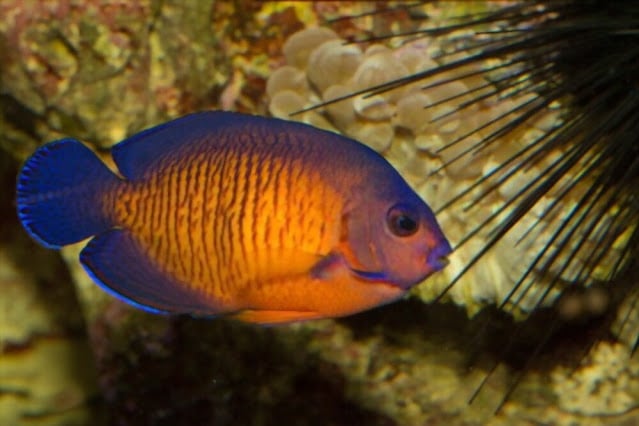
This is why they are one of the few most popular fish in the aquarium trade and are seen as a part of most saltwater community aquariums.
Providing Your Fish A Sense of Security
The primary purpose of all the caring measures taken in the tank is to make your possession stress-free and give it a bit of sense of natural habitat.
The coral beauty angelfish is a reef and lagoon dweller fish in the wild where it is found grazing on the live rocks and hiding in the rocky crevices and natural cracks whenever it feels any danger.
So, to keep this eye captivating little fish stress-free, the tank must be provided with plenty of live rock formations and rocky cracks, which would serve the purpose of hideouts for your fish.
As a result, your fish would feel more secure, easy, and stress-free. And a stress-free fish is a guarantee to strong immunity against the infections
Feeding & Maintaining The Water Conditions
Feeding is the first and foremost thing in caring for a fish, and the coral beauty angelfish is no exception.
The live rock formations in the tank would provide them spaces to hide and rest and are a source of food for them. The algae grown on the live rocks are eaten up by the coral beauty angels.
The other meaty and prepared foods are also included. Water conditions must be maintained according to what this fish naturally needs. If water conditions are not promising, you cannot expect your fish to be happy and healthy.
Coral Beauty Angelfish Diet & Feeding
In the wild
The pygmy angelfish is an omnivorous fish. It primarily feeds on the herbivorous diet, the algae growing on the rocks, and the reefs’ stony substratum.
What Do Coral Beauty Angelfish Eat? A Complete Food List & Feeding Ways
They also ingest small invertebrates like crustaceans living in the algae on the rocks. So, in the wild, the algae are their dietary staple.
The coral beauty angelfish is known to swim through the caves and stony cracks in the reef almost all of its active time and grazes on the marine weed and algae growing on them.
Because of this reason, they are one of the most important controllers of algae growth in the lagoons and the reefs.
In Captivity
While being housed, algae would still make up a large portion of their diet. That is why the aquarium for the coral beauty angelfish must be provided with many live rocks and hard substrates with a fair amount of algal growth on them.
They can also be provided with fresh and dried marine algae if the rock’s algal growth is not sufficient. Apart from their instinct of grazing, they must be provided with a variety of omnivorous diets.
Live and frozen foods like small shrimps would be a good source of their proteinic requirements.
The prepared foods like flakes, pellets, and the special foods designed for the angelfish must be provided to the fish. It can take time for them to get used to the flakes.
Food List for Coral Beauty Angelfish
Being omnivorous feeders, both herbaceous and meaty diets are essential for the coral beauty angelfish’s growth and health.
What Do Guppies Eat? ( Diet Guide)
You cannot feed them with the algae alone. If you do so, you will deprive your coral beauty of a lot of nutritious elements that can cause impaired functions and declining health of your coral beauty angelfish.
Listed below are foods that coral beauty angelfish love to eat.
| Algae / Herbs | Meaty Foods | Prepared Foods |
|---|---|---|
| Turf Algae | Mysis Shrimps | Flake Foods |
| Macro Algae | Clams | Pallets |
| Diatoms | Mussels | Angel Formula Fish Food |
| Sea Lettuce | Krill | |
| Crustose Coralline Algae | Squids | |
| Weeds | Shaved Shrimps |
Tank Size for Coral Beauty Angelfish
The coral beauty angelfish is a dwarf fish, but it needs a pretty large spaced tank. This is because of its continuous motile nature.
The average tank size recommended for a single specimen is 50-55 gallons. 75-100 gallons would be fine for a pair.
If you will have them in the form of breeding groups, then a larger tank size is recommended. The tank of 120 gallons would do an excellent job for a male and two females breeding group.
Similarly, the recommended tank size keeps on getting increased as the number of individuals in the group increases.
Tank Setup
Live Rock
The tank setup for the coral beauty angelfish needs a lot of rockwork. This fish needs rocky cracks and many live rocks making up the crevices and rubble-type areas.
Live Rock does provide them not only the food but also a lot of hiding places. The hiding places give a sense of security and ease to the fish.
If your tank is pretty large, you can have a reef aquarium because the coral angelfish is less likely to nip on the corals if the tank is huge and has many live rock formations. It is recommended to introduce these fishes last in a community tank.
Substrate
As long as the substrate is concerned, any substrate can be used as the coral beauty angelfish is a midlevel dweller where it spends most of its time circulating around the rocks and crevices. But the substrate consisting of pebbles would much be appreciated by the fish.
Light Source & Filter
A lighting source is also necessary for coral beauty angelfish aquarium as the live rocks need Light energy for the algae on them to grow. If you are planning to breed your fish, then the soft blue light encourages the spawning.
The filtration setup would clean up the tank water and carry out all three important filtration components.
Water conditions
Water conditions must be maintained for your coral beauty angelfish, and water changes must be made monthly or weekly.
Being tropical, the coral beauty angelfish performs well in a temperature range of 22-27 degrees Celsius with pH 8.1 to 8.4 and the dkH value from 8 to 12.
Coral Beauty Angelfish Tank Mates
Coral beauty is a semi-hostile fish that can act aggressively towards other same-sized or smaller tank mates, especially when they are algae eaters.
This dwarf angelfish can even turn territorial towards other angelfish species and become stressed even in a larger tank.
Among all other angelfish species, coral beauty angelfish are the only fish that is least likely to nip on the corals if placed in a large tank.
Some of the fishes that can become the compatible tank mates of the dwarf angels are given as follows.
- Members of the same species in the form of breeding groups but the two males will fight to the death
- Peaceful fish like gobies, fairy wrasses, dartfish, etc.
- Large semi-aggressive fish like tang, large angles, large wrasses, etc.
- Semi aggressive fish like clownfish, anthias, dwarf angles, etc.
Coral Beauty Angelfish Reef Safe
The coral beauty angelfish do not necessarily nip on the corals, but they can. They are omnivorous and because of their diversified nutritious requirements.
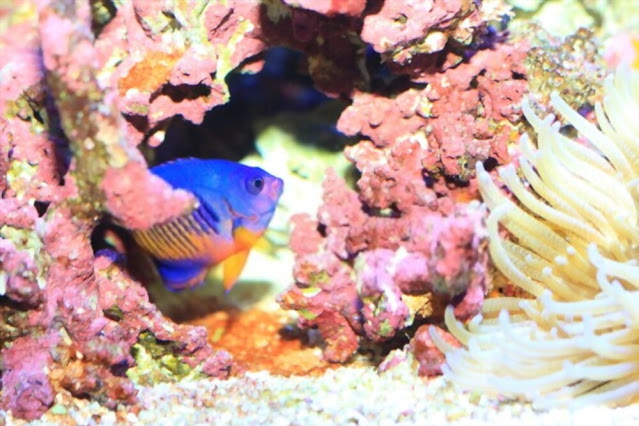
They are also reported picking up on the soft polyps and the claims. It is not necessary that they would nip on the soft coral polyps. It’s just that they can do it exceptionally.
With that being said, the coral beauty angelfish is not exactly safe for the reef tank. But if the cautions are being carried out properly, they can share the tank with the corals.
Obviously, the most crucial caution that must be taken to prevent your Coral beauty angelfish from picking up your prized corals includes feeding them with the best suitable diet on a proper timing schedule.
If your tank has live rock formations with profitable algae growth and you are feeding your coral beauty a varied omnivorous prepared and frozen diet as well, you may not need to worry about your corals.
Summary
The coral beauty angelfish inhabits the tropical waters of Indo pacific oceans, where it is found living in the coral reefs and shallow water lagoons.
The beauty of coral beauty angelfish is eye-catching. Moreover, the hardy nature makes it a trendy fish in the aquarium trade.
There are no special requirements to keep this fish in your tank, and also the coral beauty angelfish care is not that difficult as many people think.
That’s why these days, the business of their captive breeding is flourishing more and more. The captive breeds are successful dwellers of the aquarium than the wild-caught ones.
It is good to go in your saltwater tank as long as the water conditions are optimally maintained and they get enough of the varied diet.
FAQs
How do you take care of coral beauty?
Care for coral beauty angelfish is not that hard as many people think. You just need to maintain the tank conditions, including water and temperature.
Provide algae foods, meaty foods, and prepared foods as per their need for coral beauty angelfish. You do not need any special skills for the care of coral beauty angelfish.
Do Coral beauties eat algae?
Coral beauties can also be provided with fresh and dried marine algae if the algal growth on the rocks is not sufficient. Apart from their instinct of grazing, they must be provided with a variety of omnivorous diets.
What do Coral Beauty Angelfish eat?
Coral Beauty Angelfish love to eat Algae, Meaty foods, and prepared foods. You can feed them Turf algae, Sea lettuce, Mysis Shrimps, Clams, Krill, Flake foods, and Pallets.
How big does a Coral Beauty Angelfish get?
The coral beauty is a small colorful version of angelfish reaching only up to a maximum length of 4 inches. While the smaller members are just 1 inch or a little more below 2 inches long.
Are Coral Beauty Angelfish Reef Safe?
The coral beauty angelfish do not necessarily nip on the corals, but they can. They are omnivorous and because of their diversified nutritious requirements.
With that being said, the coral beauty angelfish is not exactly safe for the reef tank. But if the cautions are being carried out properly, they can share the tank with the corals.
Are there dwarf angelfish?
Yes! Coral beauty angelfish is one of the most pet fishes in the aquarium trade and is very popular among beginners as well as expert aquarists.
Coral Beauty Angelfish is a dwarf angelfish belonging to the genus ‘centropyge.’ Scientifically, it is known as Centropyge bispinosus, while commonly people have given it different names such as Dusky Angelfish, Spine angelfish, and of course the Coral beauty fish.
How long do Coral Beauty Angelfish live?
The coral beauty angelfish can be your companion for a long time but not longer than that of in the wild. It can live up to 10 to 15 years in the wild.
